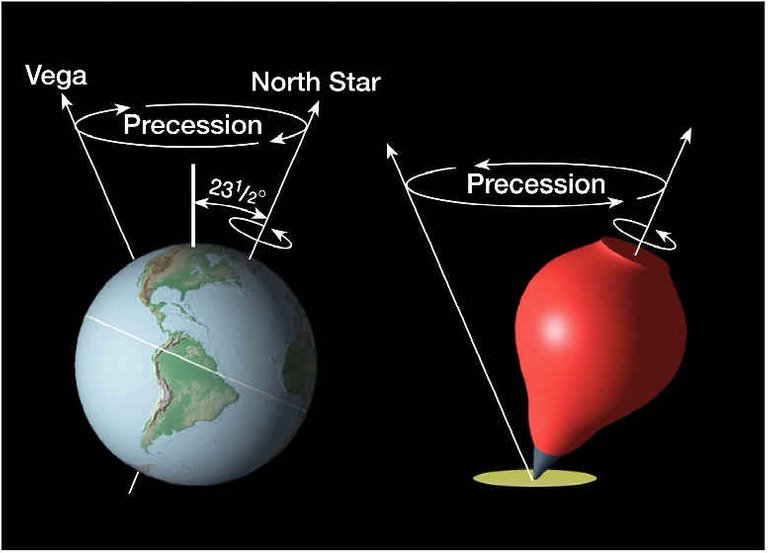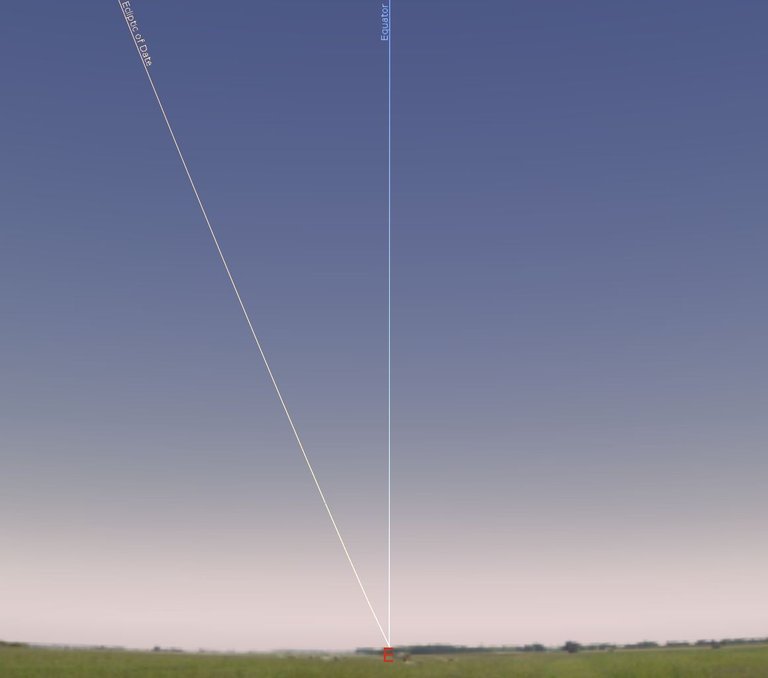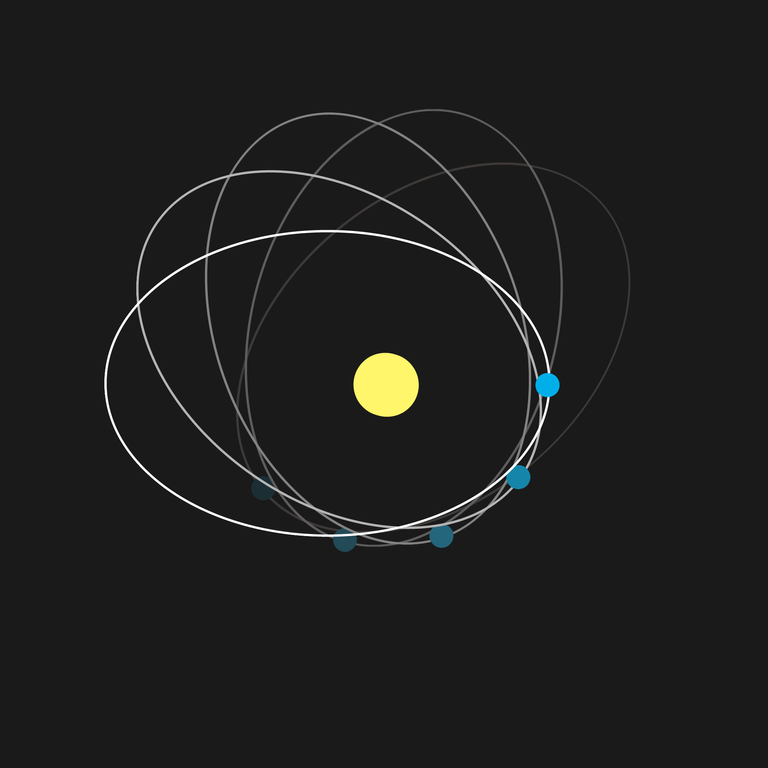
Like a big top, the Earth 's spin precesses. Image source
I touched on this topic with my last post about the North Star, Polaris, and latitude. Now I'll explain precession a bit more in detail.
Simply put, precession is the "wobble" of the Earth's rotational axis with respect to the "fixed" stars. It has two observable effects, which have been known since the days of the ancient Greeks.
I mentioned one effect in my last post: that Polaris has not always been the North Star and will not be the North Star in a few thousand years. This is the precession of the Celestial Poles.
The other effect is the precession of the equinoxes, which affects when the Sun appears to pass through each of the constellations of the zodiac.
Precession happens when a spinning object experiences a force acting some distance from its axis of rotation. For example, if you spin a coin on its edge, as its spin slows down, it will start to tilt closer and closer to the tabletop until it finally stops. The external forces being applied are gravity (downward) and the friction of the air and tabletop on the moving coin (lateral).
A spinning gyroscope will behave similarly. As its spin slows down, the top of the gyro will move in a circle, mostly because gravity is trying to tip the gyro onto its side. The gyroscopic effect "fights" the tipping over, though, so the gyroscope doesn't fall over until its spin is too slow to keep it upright.

Source: Wikimedia Commons
Of course, the Earth is not spinning on a surface. It's rotating about its axis in the vacuum of outer space, once each day, and it's been rotating a very long time -- at least 4.5 billion years. What external forces act on it?
Friction in outer space is almost non-existent, so we can ignore it. But there is still gravity: the Sun and the Earth pull on each other, as do the Moon and the Earth. Those gravitational pulls destabilize the Earth's rotation, and the result is the very slow wobble of the Earth's axis over 26,000 years.
Precession is so slow that no one could notice any difference within a single lifetime, unless they were taking very careful measurements. Over thousands of years, however, precession is quite apparent.
The ancient Sumerians and Babylonians kept very careful astronomical records, including star charts. During those times, about 4,000 years ago, the North Star was Thuban (α Draconis) in the constellation Draco. Those records passed into the hands of the Egyptians and other civilizations, and eventually were studied by the Greeks some 1,800 years later.
By that time, Thuban was no longer close to the North Celestial Pole. The honor of being the North Star had passed to one of the stars in the Little Dipper, Kochab (βUrsae Minoris), one of the stars forming the cup of the Little Dipper. By the year AD 1, the designation of "the North Star" had passed to Polaris (α Ursae Minoris), where it remains today.

The precession of the North Celestial Pole. NEP is the North Ecliptic Pole. Source: Wikimedia Commons, annotated by author
The Greek scholar, Hipparchus (c. 190 – c. 120 BC), is generally regarded as the first to discover precession, though there is some debate on that matter. Hipparchus had observed the other effect of precession, the changing position of the equinoxes relative to the stars.
Most people regard the equinoxes as dates on the calendar -- the first days of spring and autumn -- but the equinoxes have a more fundamental meaning. They are the intersections of the celestial equator with the ecliptic, or in more terrestrial terms, when the Sun rises due east and sets due west, and there are 12 hours of day and 12 of night. (Equi - nox is from the Latin words meaning equal - night.)
To ancient civilizations, the equinoxes were important dates, signaling the beginning of the planting season and the beginning of the harvest season. And ancient astronomers realized those dates coincided with the position of the Sun within particular signs of the zodiac.
Maybe I should take time out to explain some terms.
The celestial equator is the projection of the Earth's equator into the sky. If you were standing on the Earth's equator, in Ecuador for example, the celestial equator would span the sky from a point due east to due west and passing over the point directly over your head.

Standing on the equator, the celestial equator is perpendicular to the horizon. The ecliptic makes a 23° to it. Image source: Stellarium for Windows
The ecliptic is the apparent path of the Sun across the sky. It's equivalent to the plane of the Earth's orbit. The Earth's axis is tilted about 23° relative to the ecliptic, so the celestial equator makes a 23° angle with the ecliptic.
The zodiac is the set of constellations through which the Sun appears to pass during the course of a year. The Western countries have inherited these constellations from the ancient Babylonians, Egyptians, Greeks and Romans: Aries, Taurus, Gemini, Cancer, Leo, Virgo, Libra, Scorpio, (Ophiuchus), Sagittarius, Capricorn, Aquarius and Pisces. Because the Babylonians had a 12-month calendar, as we do now, there are 12 signs of the zodiac -- Ophiuchus was omitted, poor fellow -- and Sun was assumed to spend about a month in each constellation.

The red line is the ecliptic and the pale blue line is the celestial equator. The yellow arrow points to the current spring equinox in Pisces. Aries is to the left, Aquarius to the right of Pisces. Source: Wikimedia Commons
[Incidentally, since the planets and the Moon all orbit the Sun in roughly the same plane, the Moon and planets also appear in the zodiacal constellations, too.]
During Babylonian times, the spring equinox happened when the Sun was in the constellation Taurus -- that is, the ecliptic and the celestial equator intersected in Taurus. By the time of Hipparchus, the spring equinox was in Aries, which he knew did not correspond to the position recorded by the Babylonians. He realized the equinoxes (and by extension the North Star) were not permanently fixed in space.
Now the spring equinox (for the northern hemisphere) is in Pisces, and will pass into Aquarius around the year 2700. Source The autumn equinox is 180° away, in the constellation Virgo. (Folks in the southern hemisphere can switch the seasonal designations.)
The precession of the equinoxes means that the dates of the Sun's "visitations" to each sign of the zodiac have also changed over time. For example, someone born on January 28 in the time of Hipparchus would have been considered to be born under the sign of Aquarius, but in 2017 the Sun is actually within Capricorn on that date. So that person should read the horoscope for Capricorn. if he or she believes in astrology!
The orbits of the planets also precess, relative to the distant stars. The planet with the fastest orbital precession is Mercury, which is closest to the Sun. The observation that Mercury's orbit was not fixed in space, but slowly changed over time perplexed astronomers until Albert Einstein proposed his famous solution in 1916.

Precession of the orbit of Mercury (exaggerated) Source: Wikimedia Commons)
Einstein proposed that the force of gravity near the Sun was somewhat greater than Newton's Law of Universal Gravitation predicted. As Mercury approaches perihelion (the closest point to the Sun), it speeds up just a little more than predicted by Newton's law and so follows a different path each time it goes around the Sun. Einstein's calculations agreed with observations, and that correspondence was one of the earliest verifications of his General Theory of Relativity.
So, the next time you spin a coin on a tabletop, consider how that little trick has important connections to the universe around us.
Thanks for reading this far! Have a great day!

click here.Congratulations @wheatdogg, this post is the third most rewarded post (based on pending payouts) in the last 12 hours written by a User account holder (accounts that hold between 0.1 and 1.0 Mega Vests). The total number of posts by User account holders during this period was 1258 and the total pending payments to posts in this category was $2131.38. To see the full list of highest paid posts across all accounts categories,
If you do not wish to receive these messages in future, please reply stop to this comment.
Congratulations @wheatdogg! You have completed some achievement on Steemit and have been rewarded with new badge(s) :
Click on any badge to view your own Board of Honor on SteemitBoard.
For more information about SteemitBoard, click here
If you no longer want to receive notifications, reply to this comment with the word
STOPCongratulations @wheatdogg! You have completed some achievement on Steemit and have been rewarded with new badge(s) :
Click on any badge to view your own Board of Honor on SteemitBoard.
For more information about SteemitBoard, click here
If you no longer want to receive notifications, reply to this comment with the word
STOP